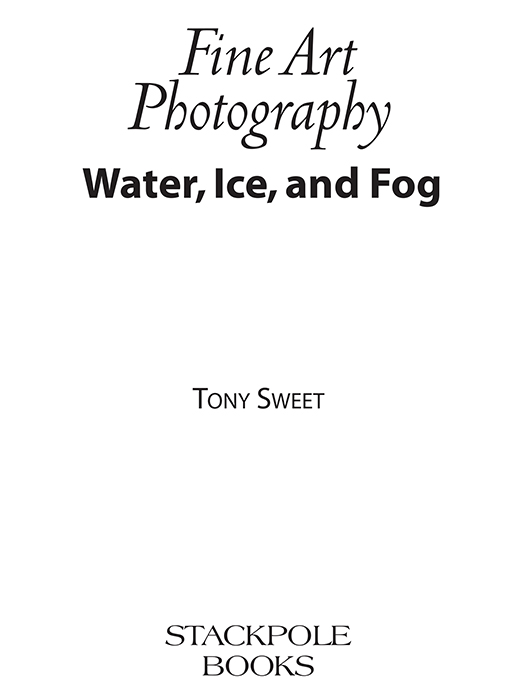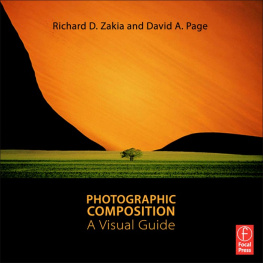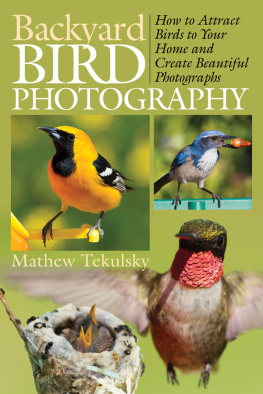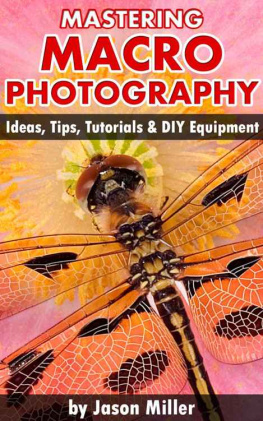

Copyright 2007 by Stackpole Books
Published by
STACKPOLE BOOKS 5067 Ritter Rd.
Mechanicsburg, PA l7055
www.stackpolebooks.com
All rights reserved, including the right to reproduce this book or portions thereof in any form or by any means, electronic or mechanical, including photocopying, recording, or by any information storage and retrieval system, without permission in writing from the publisher. All inquiries should be addressed to Stackpole Books, 5067 Ritter Road, Mechanicsburg, Pennsylvania l7055.
Printed in the United States of America
l0 9 8 7 6 5 4 3 2 l
First edition
Cover design by Caroline Stover
Cover photo by Tony Sweet
Library of Congress Cataloging-in-Publication Data
Sweet, Tony, l949
Fine art photography: water, ice, and fog / Tony Sweet. p. cm.
ISBN-l3: 978-0-8117-3349-6
ISBN-l0: 0-8ll7-3349-1
l. Photography, Artistic. 2. Photography of water. I. Title. TR642.S975 2006
778.93dc22
2006004025
eBook ISBN 978-0-8117-4282-5
For my daughter, Kelly Marie
Foreword
ARTISTS HAVE ALWAYS DRAWN FROM THE ELEMENTS OF NATURE FOR THEIR inspiration. Indeed, the word elemental means getting to the basis of things, to their core nature and being. The elements are rarely static, however, and change energy and appearance by changing states. Water, the subject of this books observations, can be liquid, solid or behave like a gas, dispersed in fine particles through atmosphere as fog. Whats fascinating is that those states shift by a slight change in temperature or interaction with another element, air, which is hotter or colder than the water itself. This dance continues every moment, every day in the world around us. All this, and the way the interaction between water and air changes every object, animate and inanimate, it enfolds is a feast for a photographers eye.
Photographers have a distinct advantage in being able to capture moments within this dance, as they can literally draw from nature and record often-fleeting phenomena or states of being in an instant with the click of a shutter. But, being able to capture the essence of a moment takes more than snapping the shutterit involves both technical and aesthetic considerations. That in large part is what Water, Ice, and Fog is aboutnoticing what these elements and their states offer us and then being able to capture that quality in a photograph.
Leafing through these pages will certainly yield rewards in the sheer beauty of the images and the tender awareness of Sweets eye. But, theres a bonus contained as well, the experience and technical expertise he has gathered to be able to translate that eye to film or memory card. In that sense it is like a phrase book one travels with in a foreign country, one that allows you to make your way through a world where familiar things are inaccessible without the proper words. The words here are meant to be a translation and guide to help you capture that special dance.
This book may change the way you see. Yes, it is a rational approach to working with water, ice, and fog in that it explores the ins and outs of lenses, exposure and all the technical matters that allow you to capture what your eye sees. But it is also, I think, an appreciation of how the elements make every moment unique, and tempts us to break away from our rushed existence and fall in love once again with their special charms. It breaks away from all the cultural distractions and offers us an almost visceral relationship with the world through our minds eye. In fact, I encourage you to begin this book by leafing through the pages and simply looking at the images. Then take a walk and see through Sweets eyes, if only for a few hours. When you return you can then begin to study with him, to learn how what you see can be captured using his experiences and special techniques.
Sweets book is about perception and application, about appreciation and tools. It explores moments that reveal the nature of water and how various atmospheric conditions enhance its qualities. It illustrates and explains how you can exploit those coincidences to make great images.
George Schaub
Prelude
ONE OF MY FAVORITE QUOTES IS BY THE AMERICAN NATURE PHOTOGRAPHER Pat OHara, who said, Water is the parent of many of my discoveries. To nature photographers, a stream, a waterfall, heavy dewdrops on a flower, a crisp early-spring or early-fall fog, a reflection lake, even rain and falling snow attract like a visual magnet. The use of various f-stops and shutter speeds affects the emotional impact of moving subjects such as a river or rolling clouds. The image-making possibilities when photographing water, in its various states, are endless and wonderful.
When approaching a scene, there is the initial, visceral reaction when we know that something is there to be photographed. Then we look around and discover interesting elements, textures, and subjects to explore. After taking a few snapshots, with minimal attention to creative composition, many photographers move on to the next subjectwhat I call the hit-and-run approach to photography. As an example, the average visitor to the Grand Canyon stays for about 20 minutes. Seriously, the tourist drives up to an overlook, gets out of the camper, and takes a picture. This process is repeated for several overlooks, and then the person drives off. In contrast, in Pat OHaras book Wilderness Scenario, he mentions spending 8 hours photographing a floweran example of the working-the-subject approach. In the hit-and-run approach, there is little room for interpretation because there are little time and thought involved in the process. The working-the-subject approach involves all three: time, thought, and interpretation. It may require the use of different lenses, filters, and depths of field; multiple exposures; painterly camera movement; different angles; and, in close-up work, various degrees of magnification. This book deals with the latter approach. None of the images in this book are snapshots. Although there are some before-and-after image examples, very few of the shots in the book were the first shot taken at the scene. There was an interpretive process involved in each. If a subject is worth photographing, its certainly worth more than a snapshot!
This book is the third in the Fine Art Photography series which explores ways of portraying various natural scenes and the creative process involved. In Fine Art Photography: Water, Ice, and Fog, we embark on the illusive process of interpretation. After finding a subject, how do we interpret the scene to best express our photographic vision? And how do we know when were done and can move on? The answer to the first question is based on imagination, experience, and persistence. The answer to the second question is based on an internal feeling of completion. For me, when I find a great subject and work through the process, there is an excitement, like a shimmering feeling, an internal groove. I just start using different lenses and filters and finding different compositions, as if on automatic pilot. After a while, there is a noticeable emotional drain and things become very quiet internally. Thats when I know that Im finished. This experience is known as being in the moment or in the zone. Its actually a common experience for artists, musicians, athletes, and others who can free their minds and become one with an experience.
Unlike the previous two books in the series, there is very little in the way of specific instruction in this book. Interpretation is subjective and cannot be systematically taught, but many approaches can be shown and illustrated in the hope that the concept will be gleaned.
Next page









